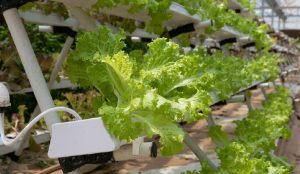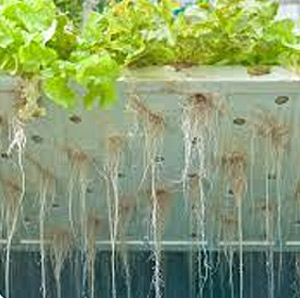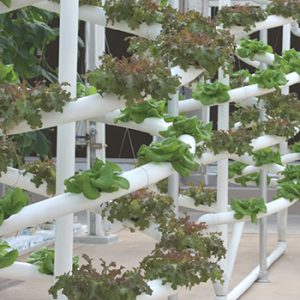
Soilless farming: Evolving market dynamics holds potential to transform the horticultural ecosystem
Soilless farming – An Introduction
The art and science of growing crops without soil is called “soilless cultivation” fundamentally referring to the technology of not having soil as the rooting medium. The plants receive their nutrition through a nutrient solution, that is recycled and the excess of which is drained off, recycled, and reused. This not only controls the nutrient uptake but also saves water and optimizes the need for pesticides. It also saves time, space, labour and renders pollution free plants which can be traced back to their source. Soilless farming systems help to obtain better produce quality and higher yields. Soilless farming is not affected or restricted by natural conditions and does not depend on the type of soil or the quantum of available water and hence can be implemented across the globe irrespective of the climatic conditions. Soilless cultivation addresses challenges posed by soil-based agriculture such as soil-borne diseases, soil degradation and limited water availability. It can reduce the environmental impacts posed by conventional agriculture
There are mainly three soilless production systems commonly used which include hydroponics (use of water), aeroponics (a subset of hydroponics using mist rather than running water) and aquaponics (food production system that combines hydroponics and aquaculture that raises marine life in a symbiotic system with plants). High-tech greenhouse setups offer a potential to control the required supply of nutrients and plant protection production as well as enable year round production. These farms are set up mostly in urban or peri-urban settings with different business models. The adoption of these technologies depends on the ease of implementation, accessibility, competitive cost effectiveness as well as consumer benefits from the quality produce using soilless cultivation.
Soilless farming: Evolving market dynamics holds potential to transform the horticultural ecosystem
 Soilless farming has the potential to transform the development of urban horticulture offering fresh, safe, healthy, and residue free produce. The technology has the potential to address countries diminishing availability of additional agricultural land, fertile soil to meet the demands of the ever growing population. Soilless cultivation is the best choice to overcome the problems of soil and for efficient utilization of water and nutrients.
Soilless farming has the potential to transform the development of urban horticulture offering fresh, safe, healthy, and residue free produce. The technology has the potential to address countries diminishing availability of additional agricultural land, fertile soil to meet the demands of the ever growing population. Soilless cultivation is the best choice to overcome the problems of soil and for efficient utilization of water and nutrients.
The Indian agribusiness ecosystem has witnessed a significant evolution in the soil less farming industry in the last five years. Today more than 40 commercial hydroponic farms are operating actively across the country. These farms are largely concentrated in the outskirts of metro and Tier I cities close to the demand centers for ease of logistics. Albeit the industry is still in its nascent stages with low awareness levels and minimal competition, the southern and western belts of India are home to a majority of these farms. The Indian hydroponics market (the major form of soilless cultivation) is expected to grow at 13.53% from 2020 – 2027. Changing dietary diversity of the health-conscious urban consumers, high disposable income, urge to adopt an improved lifestyle among urban consumers and growing awareness for healthy low-carb, keto/detox diet and organic menus have significantly increased demand for residue free leafy and exotic vegetables. This, coupled with the entry of more salad-based outlets are creating opportunities for hydroponic farms. India is importing 85% of its exotic vegetables and which is further expected to grow at a rate of 15 – 20% per year. Moreover, salad consumption has increased by 25-30% in the last 5 years. The major crops being grown using hydroponic systems include leafy greens like lettuce, pakchoi, arugula and Italian herbs, as well as vegetables like tomatoes, cucumbers, bell peppers. Cherry tomatoes, bell peppers and cucumbers account for the major share in terms of volume and value followed by the leafy greens like lettuce. Companies prefer to grow leafy greens owing to short crop cycles, less space requirement and easier management. Nutrient film techniques are the most popular technology being adopted by farms in the Indian market owing to their low cost and high productivity nature. Drip system, ebb & flow/flood drain system are the other popular technologies used. A varied range of growth mediums is used as substitute for soil in soilless farming systems like coco coir, perlite, wood, rice husk, rock wool, sand, peat moss among others.
Industry research indicates that hydroponic farming is largely B2B business with 90 – 95% catering to demand of HoReCa (hotel, restaurant and café) and organized retail. Organized retailers and high-end specialty grocery stores offer better margins to hydroponic growers compared to HoReCa, while prices remain low and undifferentiated in the case of unorganized retail. However, attracting potential customers for organized retail shopping demands for innovative packaging and organizing awareness building initiatives.  A path-breaking concept of self-sustaining food parks within the peri-urban limits of large cities using different models of soilless (protected cultivation) farming technologies to produce and provide clean and organic fresh vegetables for the nearby cities and towns are expected to drive growth for the industry. Tier II and Tier III cities are also expected to follow a similar disrupting trend in the coming years. The demand for hydroponically grown vegetables is growing faster than the rate at which farms are being built, creating a lot of opportunities for new players to dive in and offer clean and safer produce for the niche customers. Today companies like Barton Breeze and Envirevo Agritech are offering innovative solutions for the urban farmers by setting up rooftop farms equipped with remote-controlled systems and automated indoor farms for residential/commercial buildings, respectively.
A path-breaking concept of self-sustaining food parks within the peri-urban limits of large cities using different models of soilless (protected cultivation) farming technologies to produce and provide clean and organic fresh vegetables for the nearby cities and towns are expected to drive growth for the industry. Tier II and Tier III cities are also expected to follow a similar disrupting trend in the coming years. The demand for hydroponically grown vegetables is growing faster than the rate at which farms are being built, creating a lot of opportunities for new players to dive in and offer clean and safer produce for the niche customers. Today companies like Barton Breeze and Envirevo Agritech are offering innovative solutions for the urban farmers by setting up rooftop farms equipped with remote-controlled systems and automated indoor farms for residential/commercial buildings, respectively.
 In India, companies are evolving and bringing in state of the art technologies to soilless cultivation farms for improving efficiency and better management of these farms. AI based technologies are being deployed for seed profiling to determine the best germination rate, measuring optimal nutrient quantity, humidity and water content, maintaining pH levels and electrical conductivity etc. Precision Artificial Intelligence (AI) technologies are further expected to improve the efficiency of hydroponic farms by enabling automated feed control and monitoring and thus reliving farmers from giving constant attention. Investments in startups working on AI in soilless farming models (primarily hydroponics) are also witnessing an upward surge. Agro2o is planning to launch smart hydroponic gardens equipped with IoT and AI growing algorithms to drive efficiency and optimize yields. Farm management software is being deployed which can alert the farmers on pest attacks, level of infestation as well as align approximate date of harvests and expected yield. More recent technologies include robots to determine the ripeness level of fruits for targeted harvesting, for weed detection and removal etc.
In India, companies are evolving and bringing in state of the art technologies to soilless cultivation farms for improving efficiency and better management of these farms. AI based technologies are being deployed for seed profiling to determine the best germination rate, measuring optimal nutrient quantity, humidity and water content, maintaining pH levels and electrical conductivity etc. Precision Artificial Intelligence (AI) technologies are further expected to improve the efficiency of hydroponic farms by enabling automated feed control and monitoring and thus reliving farmers from giving constant attention. Investments in startups working on AI in soilless farming models (primarily hydroponics) are also witnessing an upward surge. Agro2o is planning to launch smart hydroponic gardens equipped with IoT and AI growing algorithms to drive efficiency and optimize yields. Farm management software is being deployed which can alert the farmers on pest attacks, level of infestation as well as align approximate date of harvests and expected yield. More recent technologies include robots to determine the ripeness level of fruits for targeted harvesting, for weed detection and removal etc.
As more and more start-ups enter the space with innovative solutions, the sector is sure to witness a fast growth in the coming years with the adoption of advanced technology. Automated technologies and systems will be the driving factor for transitioning into urban modern tech farming thereby aiding to meet the demands of the growing urban population. The round the year production possibility makes soilless farming systems more promising to meet the needs of growing horticulture produce. With government promoting subsidies for soilless cultivation farms, more and more entrepreneurs are leveraging the opportunity to establish commercial hydroponic farms across the major tier I cities by collaborating with regional producers and international technology providers.  The growth in the sector will parallel witness growth in demand for high quality seeds for these exotic leafy greens and vegetables as well as formulations for nutrients and pesticide for effective delivery under hydroponic systems. This opens up opportunities for the agri input industry to be prepared with novel products customized for the requirements of the soilless farming industry. Soilless cultivation technologies have the potential to transform the urban horticulture scenario.
The growth in the sector will parallel witness growth in demand for high quality seeds for these exotic leafy greens and vegetables as well as formulations for nutrients and pesticide for effective delivery under hydroponic systems. This opens up opportunities for the agri input industry to be prepared with novel products customized for the requirements of the soilless farming industry. Soilless cultivation technologies have the potential to transform the urban horticulture scenario.
Author:

Connect with Authors at: E-mail agribusiness@sathguru.com
 Grow Beyond
Grow Beyond 

